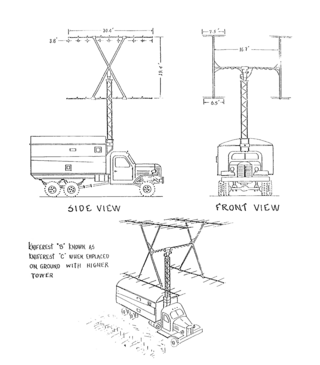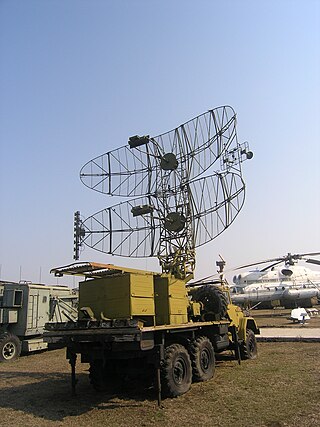A knife rest is a piece of kitchenware.
Knife rest may also refer to:
- P-8 radar, NATO reporting name "Knife Rest A"
- P-10 radar, NATO reporting names "Knife Rest B" and "Knife Rest C"
A knife rest is a piece of kitchenware.
Knife rest may also refer to:

The Boeing E-3 Sentry is an American airborne early warning and control (AEW&C) aircraft developed by Boeing. E-3s are commonly known as AWACS. Derived from the Boeing 707 airliner, it provides all-weather surveillance, command, control, and communications, and is used by the United States Air Force, NATO, French Air and Space Force, Royal Saudi Air Force and Chilean Air Force. The E-3 has a distinctive rotating radar dome (rotodome) above the fuselage. Production ended in 1992 after 68 aircraft had been built.

Project 651, known in the West by its NATO reporting name Juliett class, was a class of Soviet diesel-electric submarines armed with cruise missiles. They were designed in the late 1950s to provide the Soviet Navy with a nuclear strike capability against targets along the east coast of the United States and enemy combatants. The head of the design team was Abram Samuilovich Kassatsier. They carried four nuclear-capable cruise missiles with a range of approximately 300 nautical miles (560 km), which could be launched while the submarine was surfaced and moving less than four knots (7.4 km/h). Once surfaced, the first missile could be launched in about five minutes; subsequent missiles would follow within about ten seconds each. Initially, the missiles were the inertially-guided P-5. When submarine-launched ballistic missiles rendered the P-5s obsolescent, they were replaced with the P-6 designed to attack aircraft carriers. A special 10 m2 target guidance radar was built into the forward edge of the sail structure, which opened by rotating. One boat was eventually fitted with the Kasatka satellite downlink for targeting information to support P-500 4K-80 "Bazalt" anti-ship cruise missiles. The Juliett class had a low magnetic signature austenitic steel double hull, covered by two inches (51 mm) thick black tiles made of sound-absorbing hard rubber.

An air-to-air missile (AAM) is a missile fired from an aircraft for the purpose of destroying another aircraft. AAMs are typically powered by one or more rocket motors, usually solid fueled but sometimes liquid fueled. Ramjet engines, as used on the Meteor, are emerging as propulsion that will enable future medium- to long-range missiles to maintain higher average speed across their engagement envelope.

The Sukhoi Su-15 is a twinjet supersonic interceptor aircraft developed by the Soviet Union. It entered service in 1965 and remained one of the front-line designs into the 1990s. The Su-15 was designed to replace the Sukhoi Su-11 and Sukhoi Su-9, which were becoming obsolete as NATO introduced newer and more capable strategic bombers.

A radar picket is a radar-equipped station, ship, submarine, aircraft, or vehicle used to increase the radar detection range around a nation or military force to protect it from surprise attack, typically air attack, or from criminal activities such as smuggling. By definition a radar picket must be some distance removed from the anticipated targets to be capable of providing early warning. Often several detached radar units would be placed in a ring to encircle a target to provide increased cover in all directions; another approach is to position units to form a barrier line.

The S-75 is a Soviet-designed, high-altitude air defence system, built around a surface-to-air missile with command guidance. Following its first deployment in 1957 it became one of the most widely deployed air defence systems in history. It scored the first destruction of an enemy aircraft by a surface-to-air missile, with the shooting down of a Taiwanese Martin RB-57D Canberra over China on 7 October 1959 that was hit by a salvo of three V-750 (1D) missiles at an altitude of 20 km (65,600 ft). This success was credited to Chinese fighter aircraft at the time to keep the S-75 program secret.
The P-500 Bazalt is a turbojet-powered, supersonic cruise missile used by the Soviet and Russian navies. Its GRAU designation is 4K80 and its NATO reporting name is SS-N-12 Sandbox, its upgraded version being the P-1000 Vulkan AShM SLCM.
Downbeat, down beat or Down Beat may refer to:

The A-350 GRAU 5V61 was a Soviet, nuclear armed surface-to-air anti-ballistic missile. The A-350 was a component of the A-35 anti-ballistic missile system. Its primary mission was to destroy U.S. Minuteman and Titan intercontinental ballistic missiles targeting Moscow.

The "Pegmantit 8" or P-8 was an early 2D VHF radar developed and operated by the former Soviet Union.

The "Pegmantit 10" or P-10 was an early 2D VHF radar developed and operated by the former Soviet Union.

The P-12 "Yenisei" was an early VHF radar developed and operated by the former Soviet Union.

The P-18 or 1RL131Terek is a 2D VHF radar developed and operated by the former Soviet Union.

The P-15"Tropa" or 1RL13 is a 2D UHF radar developed and operated by the former Soviet Union.

The P-19"Danube"1RL134 is a 2D UHF radar developed and operated by the former Soviet Union. The radar was also known by the name "Renata" in Poland and "Dunai" in the former German Democratic Republic.
Pechora is a town in the Komi Republic, Russia.

The Nizhny Novgorod Research Institute of Radio Engineering (NNIIRT) is a Russian electronics company specializing in the development and manufacturing of radar equipment. It is a subsidiary of the Almaz-Antey group.
This is an overview of Russian early-warning radars for air surveillance, and related design bureaus.
A spoon rest is a piece of kitchenware.
Flat Face is the NATO reporting name for the following Soviet air defense radars: